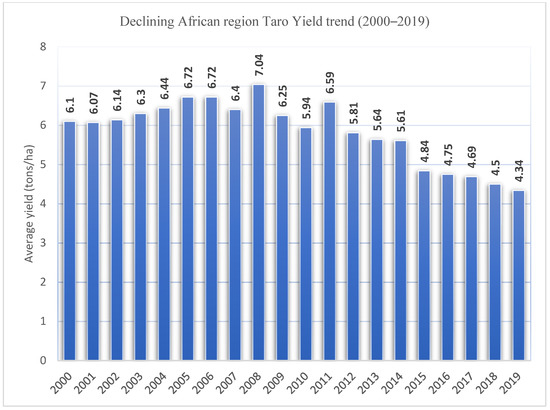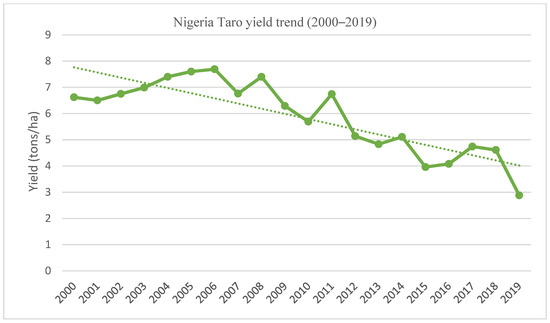Cocoyam [Colocasia esculenta (L.) Schott] also known as taro is regarded as an important staple crop in the Pacific Islands, Asia and Africa.
- Colocasia esculenta
- cocoyam
- food security
- Africa
- exports
- imports
It1. Introduction
Taro (Cocoyam) [Colocasia esculenta (L.) Schott] is an important tropical root crop grown purposely for its starchy corms or underground stem [1]. It is regarded as one of the most important staple crops in the Pacific Islands, Asia and Africa [1,2,3,4]. It is one of the oldest world’s food crops believed to have been first domesticated in Southeast Asia before its eventual spread to other parts of the world [5,6]. The two most commonly cultivated species of Taro (Colocasia esculenta and Xanthosoma sagittifolium) belong to the Araceae family and are extensively cultivated in Africa.
Taro is an herbaceous monocotyledonous plant of 1–2 m height. The plant consists of central corm (below the soil surface) making the leaves grow upwards, roots grown downwards, while cormels, daughter corms and runners (stolons) grow laterally. The root system is fibrous and lies mainly at a depth of up to one meter of soil [3,7].
In most Pacific Island countries (PICs) where taro is widely cultivated and consumed, two species of Colocasia are recognized. They are C. esculenta var. esculenta, commonly called dasheen, and C. esculenta var. antiquorum, often referred to as eddoe [3,8]. The dasheen variety possesses large central corms, with suckers and/or stolons, while eddoes have somewhat small central corm and a large number of smaller cormels [3,9,10].
In Africa, Taro is commonly produced by smallholder, resource-limited and mostly female farmers [3]. Taro ranks third in importance, after cassava and yam, among the class of root and tuber crops cultivated and consumed in most African countries [3]. The crop is underutilized in the areas of export, human consumption, industrial uses, nutritional and other health benefits in Africa. Thus, the objective of this review is to provide a critical assessment of the leading players in the taro sub-sector globally and continentally with the most recent datasets useful for policy intervention and planning. Also, this study explores the nutritional, health and economic benefits of taro highlighting the role it can play in enhancing sustainable livelihoods especially in Africa.
2. Taro [Colocasia esculenta (L.) Schott] in Africa
In many parts of the world, (especially, African countries), roots and tubers such as cassava (Manihot esculenta), sweet potato (Ipoemea batatas), yam (Dioscorea sp), and cocoyam (Colocasia esculenta and Xanthosoma sagittifolium), are important staple crops commonly cultivated by smallholder farmers and used as food security and income crops [11,44]. Taro production in Africa (especially SSA) is commonly by smallholder, resource-limited and mostly female farmers [3]. However, the crop is mostly referred to as “poor man’s crop” because its consumption is mainly by the low income households in the society [3]. As mentioned above, Africa contributed to over 70% of global taro production consistently in the past two decades and accounted for about 76 percent of world share in 2000 but, witnessed a slight decline in production levels in two decades attaining 72.27% (7.6 million tonnes) share of world total production in 2019 (Table 10) [11]. Despite the global recognition of taro production in Africa, the crop has suffered serious neglect, receiving little attention from agricultural researchers and government policymakers [3,43,44,45,46].
The world is faced with enormous task of providing sufficient food for over seven billion people, with 690 million people suffering from hunger globally, Africa region accounted for 73 million out of the 135 million people suffering from acute food insecurity in 2019 [47,48,49,50,51,52,53]. Hunger and malnutrition continue to escalate as the world’s food system is being threatened by the emergence of COVID-19 pandemic in December 2019. The attendant total and partial lockdowns in many countries has led to increased level of hunger and food insecurity. The situation in Africa is the one referred to as “a crisis within a crisis” with very high prevalence of hunger and malnutrition in most Africa countries. African governments need to intensify efforts in boosting agricultural production and keeping the food value chain active in order to stem the tide of hunger and food insecurity in the continent [54,55,56,57,58,59,60].
However, one of the means of reducing the level of hunger and protein-energy malnutrition in Africa (especially SSA) is through increased production and consumption of indigenous staples of high energy content such as taro [61,62]. Taro is recognized as a cheaper yam substitute, notably during period of food scarcity (hunger season) among many households in SSA (especially Ghana and Nigeria) and its production remained an integral part of many smallholder farming households in many parts of West and Central African countries [3]. It is worthy of note that, most of the output that placed Nigeria as number one taro producer globally and other high producing African countries like Cameroon, Ghana, Madagascar and Burundi (Figure 3) are carried out by smallholder rural farmers employing primitive technology and traditional farming practices with limited intensive management system [3,11]. Taro leaves and tubers possess excellent nutraceutical and healing properties. Thus, its increased production and consumption should be encouraged because of these properties in addition to its usefulness as a food security staple.
5.1. Recent Taro Productivity and Yield Potential in Africa


| Africa | America | Asia | Oceania | |||||||||
|---|---|---|---|---|---|---|---|---|---|---|---|---|
| Year | Prod (1000 t) | Area Harvested (1000 ha) | Yield (t/ha) | Prod (tons) | Area Harvested (ha) | Yield (t/ha) | Prod (1000 t) | Area Harvested (ha) | Yield (t/ha) | Prod (tons) | Area Harvested (ha) | Yield (t/ha) |
| 2000 | 7435 | 1219 | 6.10 | 78,815 | 7621 | 10.34 | 1931 | 128,872 | 14.98 | 318,753 | 44,362 | 7.19 |
| 2001 | 7598 | 1251 | 6.07 | 81,871 | 8118 | 10.09 | 1947 | 139,676 | 15.01 | 321,062 | 45,321 | 7.08 |
| 2002 | 8112 | 1322 | 6.14 | 85,195 | 8571 | 9.94 | 1977 | 129,322 | 15.29 | 351,476 | 48,664 | 7.22 |
| 2003 | 8330 | 1322 | 6.30 | 82,214 | 8628 | 9.53 | 2026 | 133,626 | 15.16 | 361,416 | 50,192 | 7.20 |
| 2004 | 8557 | 1329 | 6.44 | 82,252 | 8669 | 9.49 | 1952 | 131,050 | 14.89 | 390,886 | 53,390 | 7.32 |
| 2005 | 9099 | 1354 | 6.72 | 82,994 | 8915 | 9.31 | 1914 | 127,935 | 14.96 | 413,900 | 55,658 | 7.44 |
| 2006 | 9510 | 1413 | 6.72 | 81,946 | 8731 | 9.39 | 1912 | 128,569 | 14.87 | 402,449 | 54,061 | 7.44 |
| 2007 | 9129 | 1426 | 6.40 | 80,343 | 7297 | 11.01 | 2014 | 129,513 | 15.55 | 395,889 | 52,735 | 7.51 |
| 2008 | 9617 | 1367 | 7.04 | 80,878 | 7227 | 11.19 | 2023 | 130,721 | 15.47 | 413,645 | 57,708 | 7.17 |
| 2009 | 7035 | 1125 | 6.25 | 81,350 | 7207 | 11.29 | 2082 | 133,211 | 15.63 | 412,859 | 54,574 | 7.57 |
| 2010 | 6904 | 1161 | 5.94 | 55,662 | 4883 | 11.40 | 2080 | 132,285 | 15.72 | 402,545 | 52,463 | 7.67 |
| 2011 | 6993 | 1062 | 6.59 | 46,999 | 3937 | 11.94 | 2074 | 131,868 | 15.72 | 421,634 | 54,973 | 7.67 |
| 2012 | 7196 | 1238 | 5.81 | 92,574 | 9884 | 9.37 | 2180 | 133,298 | 16.35 | 383,583 | 47,503 | 8.07 |
| 2013 | 6879 | 1219 | 5.64 | 103,142 | 10,638 | 9.70 | 2213 | 134,017 | 16.51 | 432,174 | 51,472 | 8.40 |
| 2014 | 7368 | 1312 | 5.61 | 101,393 | 8830 | 11.48 | 2388 | 147,551 | 16.18 | 417,198 | 51,031 | 8.18 |
| 2015 | 7366 | 1522 | 4.84 | 133,046 | 7785 | 17.09 | 2367 | 147,251 | 16.07 | 416,183 | 48,309 | 8.62 |
| 2016 | 7472 | 1574 | 4.75 | 74,274 | 7359 | 10.09 | 2440 | 152,588 | 15.99 | 392,197 | 46,725 | 8.39 |
| 2017 | 7646 | 1630 | 4.69 | 72,755 | 6930 | 10.50 | 2409 | 148,133 | 16.26 | 396,564 | 46,566 | 8.52 |
| 2018 | 7575 | 1682 | 4.50 | 43,865 | 4408 | 9.95 | 2438 | 148,380 | 16.43 | 403,122 | 46,595 | 8.65 |
| 2019 | 7619 | 1756 | 4.34 | 54,111 | 5200 | 10.41 | 2463 | 149,256 | 16.50 | 406,386 | 46,559 | 8.73 |
5.2. Taro Trade Potentials in Africa
5.3. Challenges of Taro in Africa
The non-existent of effective research and policy interventions for the increased production and marketing (international trade) of taro in most African countries (especially SSA) has left the crop as an unpopular and under-utilized root and tuber crop when compared with other root and tuber crops such as cassava, yam and potato. The consistent increase in production levels (although with increasing reduction in yield per land area—Figure 4) of taro in most high producing Africa countries (Nigeria, Cameroon and Ghana) has not attracted the international market for more than three decades [3,6,63,64]. Taro production in most major African growing areas has remained at subsistence level with farmers depending mainly on traditional farming inputs [3,57,58,59].
To further worsen the challenges of taro production, consumption and commercialization in Africa, is the emergence of taro leaf blight (TLB) (Phytophthora colocasiae) in West Africa in 2009 [3,64]. The outbreak of TLB was opined to have accounted for more than US$1.4 billion economic loss annually with enormous impact on the genetic erosion of gene pool in the region [3]. Taro production is facing continuous decline due to rapid prevalence of TLB. This has resulted in continuous low yield, poor quality corms and reduced commercialization in most taro producing countries [3,65].
(References would be added automatically after the entry is online)
This entry is adapted from the peer-reviewed paper 10.3390/su13084483
